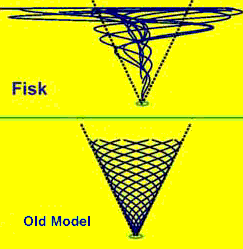
Courtesy of University of Michigan, Fisk Team.
Related links:
The Sun's Magnetic Field - New and Improved Model?
News story originally written on November 14, 1997
Lennard Fisk of the University of Michigan released a controversial model
of the Sun's magnetic field last year. His model refuted the accepted
model formed in the 1950's. More and more evidence is being collected
that supports Fisk's model. Could this be a new scientific
breakthrough!? Time will tell.
Fisk's model suggests that the magnetic field lines extending from the Sun resemble a wild cyclone (see image to the left). However, the older model suggests the magnetic field lines look like the path water would take while coming from a lawn sprinkler.
Fisk's model is based on some well-accepted solar phenomenon. It takes into account the fact that the Sun experiences differential rotation (the gases at the Sun's equator rotate faster than gas at the poles). Fisk also considered the fact that the Sun's magnetic field is not only constantly expanding, but it is slightly offset from the Sun's axis of rotation.
The old model of the Sun's magnetic field cannot explain recent data collected by the NASA/ESA Ulysses mission (which is in a unique polar orbit about the Sun). Fisk and team members Thomas Zurbuchen and Nathan Schwadron are using this data to test the variations that Fisk's model predicts.
The team admits that their model still requires extensive testing. But, "This is science at it best," says Fisk, chair of the U-M Department of Atmospheric, Oceanic and Space Sciences. "Someone observes a phenomenon, and that causes you to think about things in different ways. Then you put out a theory that says what it is, and people poke at that. You look at the observational evidence and test it out. The model will undoubtedly change -- models always do."














